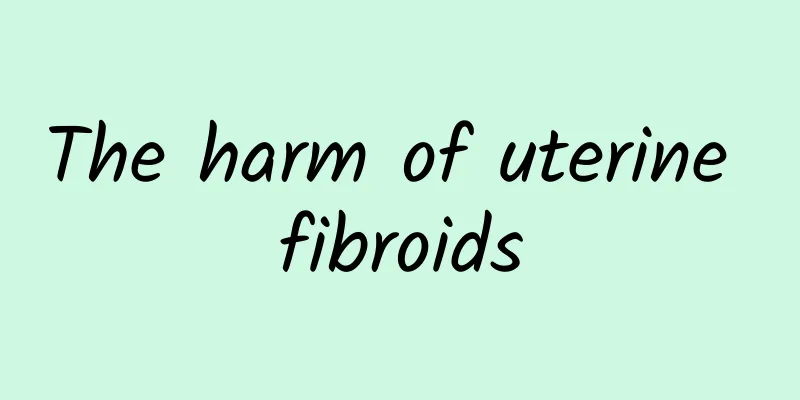What are the basic symptoms of uterine fibroids? What are the feelings and symptoms of uterine fibroids?

|
Uterine fibroids are a common benign tumor in gynecology, mostly occurring in women of childbearing age. So, what are the basic symptoms of uterine fibroids? What does it feel like? Let's take a closer look. 1. Understanding uterine fibroids Uterine fibroids, also known as uterine fibroids, are formed by the pathological proliferation of smooth muscle cells in the uterine wall. Its cause is still unclear, but it is related to genetic factors, hormonal imbalance, lifestyle, reproductive history, etc. The size and number of uterine fibroids may vary. Some patients have only one small fibroid, while others may have multiple fibroids that are large. Although fibroids are generally benign, they may also become uterine fibroid cancer in some special cases. 2. Basic symptoms 1. Abnormal menstruation: One of the most common symptoms of uterine fibroids is abnormal menstruation, which is manifested as increased menstrual flow, prolonged menstrual period, and even irregular menstruation. Some patients may also experience symptoms of dysmenorrhea. 2. Abdominal discomfort: Due to the presence of uterine fibroids, patients may feel abdominal discomfort, even abdominal pain, bloating, etc. When the fibroids grow and compress the bladder, patients may also experience symptoms of frequent urination and urgency. 3. Compression of adjacent organs: If uterine fibroids grow larger and compress adjacent organs, the patient may experience constipation and difficulty urinating. 3. Feeling and Experience Uterine fibroids can have a certain impact on patients' physical and mental health. Patients may experience abdominal discomfort, which may make them feel tired. Heavy menstrual bleeding may also lead to anemia, further aggravating fatigue. Abnormal menstruation and abdominal pain may affect patients' quality of life and make them feel physically and mentally uncomfortable. IV. Medical advice Once the basic symptoms of uterine fibroids appear, it is recommended to see a doctor as soon as possible to get the correct diagnosis and treatment. Usually, the doctor will determine the location, size and number of fibroids through physical examination, ultrasound, MRI, etc. There are various treatment methods, including observation, drug therapy and surgery. The specific treatment plan will be determined according to factors such as the patient's age, fertility plan, and the severity of symptoms. The basic symptoms of uterine fibroids include abnormal menstruation, abdominal discomfort, and various problems caused by compression of adjacent organs. For patients, these symptoms may cause physical and psychological discomfort. Therefore, once similar symptoms occur, it is recommended to see a doctor as soon as possible and receive appropriate treatment according to the doctor's advice to improve the quality of life and prevent the disease from worsening. For women, regular physical examinations and lifestyle adjustments are also important measures to prevent uterine fibroids. |
Recommend
Three common methods of treating vaginitis
The treatment of vaginitis is a topic of concern ...
Obese men may have less semen, lower semen quality and may become infertile! Dr. Liu Boen: 3 tips for obese men to lose weight
Due to the impact of the declining birth rate, th...
Treatment methods for multiple uterine fibroids How are multiple uterine fibroids treated by traditional Chinese and Western medicine?
Nowadays, there are indeed many ways to treat ute...
Does cervical erosion need to be treated immediately?
Cervical erosion is quite common in daily life. F...
Do you still need to eat starch to lose weight, otherwise you will easily gain weight again? Nutritionist Cheng Mingwei: Master 4 starch weight loss techniques
People who are trying to lose weight seem to have...
What is the reason for less menstrual flow?
The decrease in menstrual flow is due to the decl...
The causes of multiple uterine fibroids How do multiple uterine fibroids form?
Women with childbearing experience are immune to ...
3 conditions that must be met for medical abortion
Medical abortion, also known as drug abortion, re...
Get rid of muscle soreness after exercise! Eat like this according to the three iron nutritionist
Have you finally made up your mind to exercise, b...
What are the early symptoms of ectopic pregnancy?
Ectopic pregnancy is a very common disease in cli...
How to treat severe dysmenorrhea, is medication or surgery better?
If you suffer from severe dysmenorrhea, you can c...
What should I do if I have abdominal pain every time I have my period?
What should I do if I have abdominal pain every t...
Eating mutton hotpot warms the middle and replenishes deficiency. Female traditional Chinese medicine practitioner's 3 secrets of eating tonic but not fat
The weather is getting cooler, and the whistle of...
Choosing the right treatment for cervical erosion
There are many ways to treat cervical erosion, bu...
What should I do if I have irregular menstruation and dysmenorrhea?
What should I do if I have irregular menstruation...









